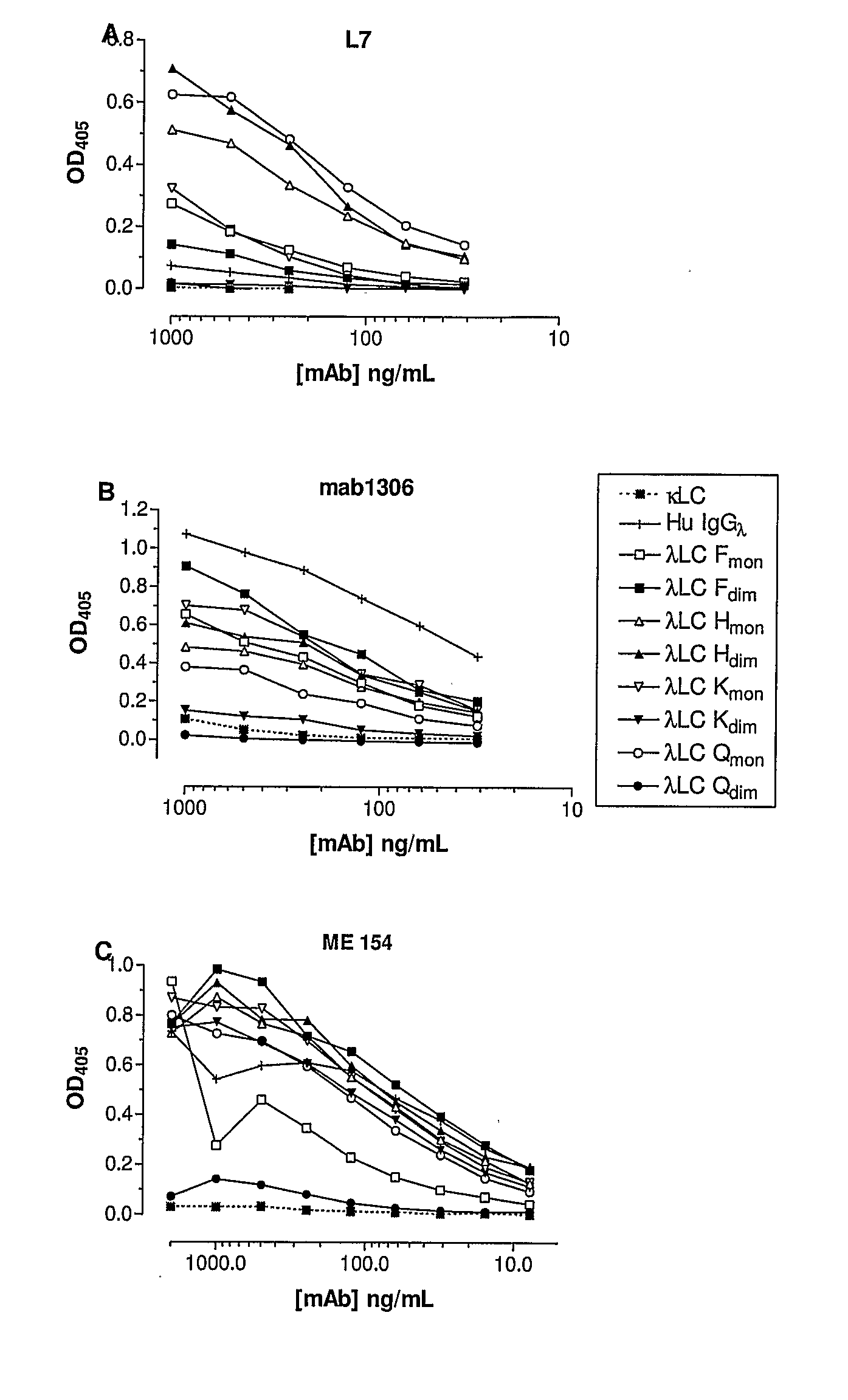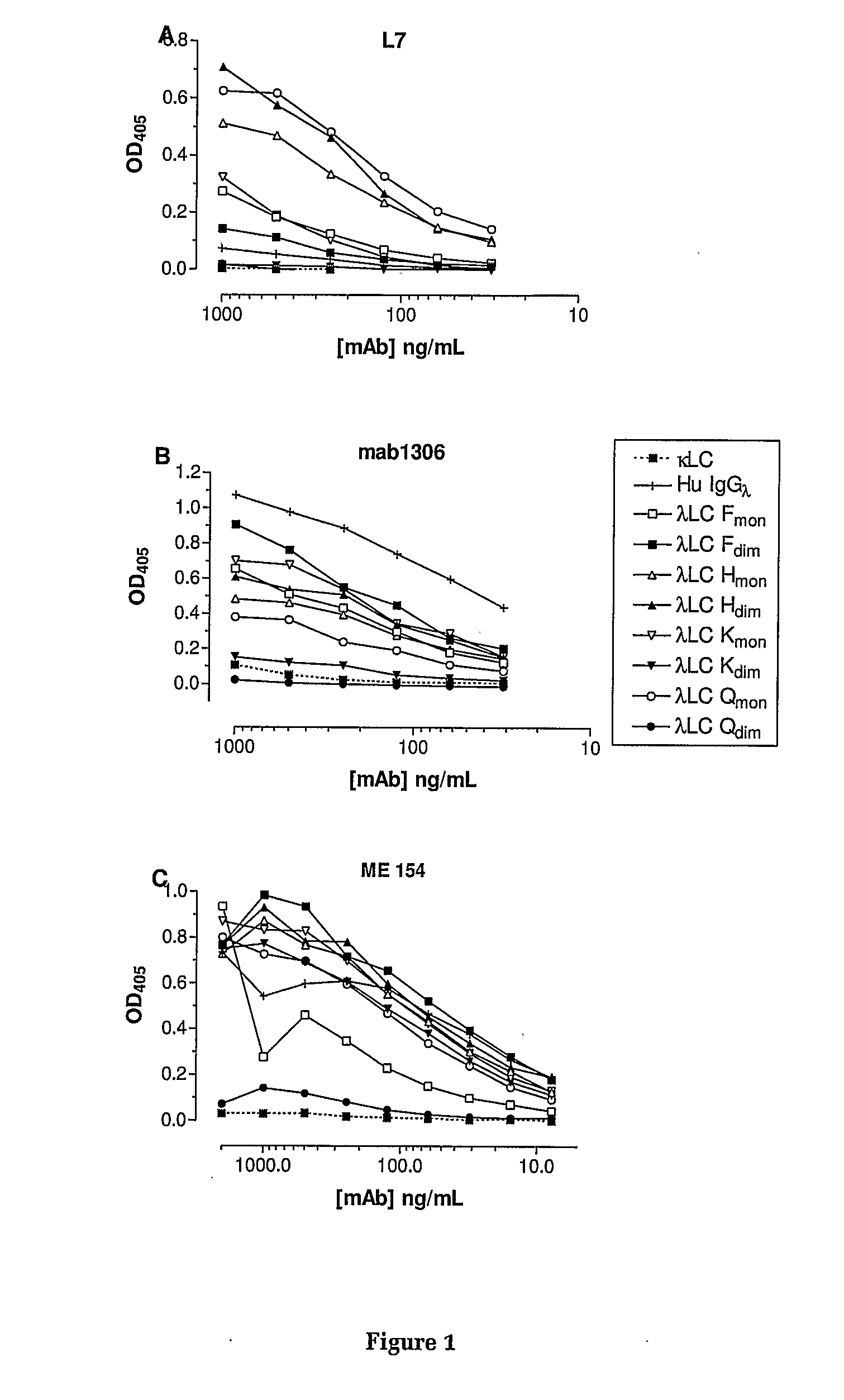Targer For B-Cell Disorders
a b-cell disorder and tumor cell technology, applied in the field of tumor cell disorders, can solve the problems of re-population of bone marrow with malignant cells, contaminated autologous peripheral stem cells, and inability to meet the needs of patients, so as to increase tumor cell killing, and increase the effect of host defence mediated processes
- Summary
- Abstract
- Description
- Claims
- Application Information
AI Technical Summary
Benefits of technology
Problems solved by technology
Method used
Image
Examples
example 1
Specificity of the Antibodies L7, mab 1306 and ME 154 for λ Light Chain
[0162]The specificity of L7 binding to human free lambda light chains is shown in FIGS. 1A and 2A. These results indicate that L7 binds to both the monomer and dimer forms of three different lambda light chains (Lam F, Lam H and Lam K), and to the monomeric form of a fourth lambda light chain (Lam Q). The antibody does not bind to lambda light chains associated with heavy chain in normal human immunoglobulin, nor does it bind free kappa light chains.
[0163]The antigen binding properties of mabl306 to a range of human lambda light chains is shown in FIGS. 1B and 2B. These results demonstrate that mabl306 binds to a range of free and immunoglobulin-associated λ.LCs but does not bind to free κ.LCs. Similarly, mAb ME 154 binds to both free and heavy chain associated λ LCs (FIG. 1C). All three mAbs show binding to the monomeric form of Lam Q but not to the dimer form of this antigen.
example 2
Identification of λ Light Chains on LP-1 Myeloma Cells
[0164]Flow cytometry results indicate that L7, mabl306 and ME 154 all bind specifically to a cell surface antigen on LP-1 myeloma cells (FIG. 3). For mAb L7, antibody binding to LP-1 cells is inhibited by pre-incubation with two different monomeric free lambda light chains, Lam F and Lam H (FIG. 4). This inhibition occurs in a concentration-dependent manner (FIG. 4B), however L7 binding is not inhibited by an equivalent concentration of free kappa light chain.
[0165]The presence of a free λ light chain antigen that is not associated with Ig heavy chain was demonstrated on the surface of LP-1 cells using fluorescence microscopy (data not shown). Incubation of the cells with fluorescently labelled polyclonal antibody specific for the IgG gamma chain (anti-γ-FITC) showed non-uniform intensity of green staining of LP-1 cells, whereas polyclonal antibody against λ light chains, anti-λ-Texas Red, showed several patches of intense red on...
PUM
| Property | Measurement | Unit |
|---|---|---|
| concentrations | aaaaa | aaaaa |
| concentrations | aaaaa | aaaaa |
| volume | aaaaa | aaaaa |
Abstract
Description
Claims
Application Information
 Login to View More
Login to View More - R&D
- Intellectual Property
- Life Sciences
- Materials
- Tech Scout
- Unparalleled Data Quality
- Higher Quality Content
- 60% Fewer Hallucinations
Browse by: Latest US Patents, China's latest patents, Technical Efficacy Thesaurus, Application Domain, Technology Topic, Popular Technical Reports.
© 2025 PatSnap. All rights reserved.Legal|Privacy policy|Modern Slavery Act Transparency Statement|Sitemap|About US| Contact US: help@patsnap.com



